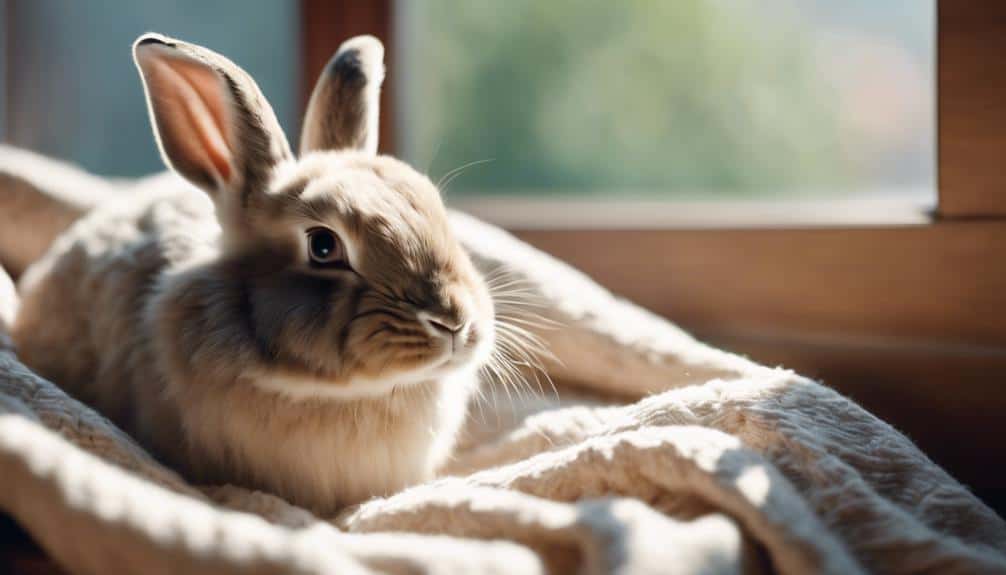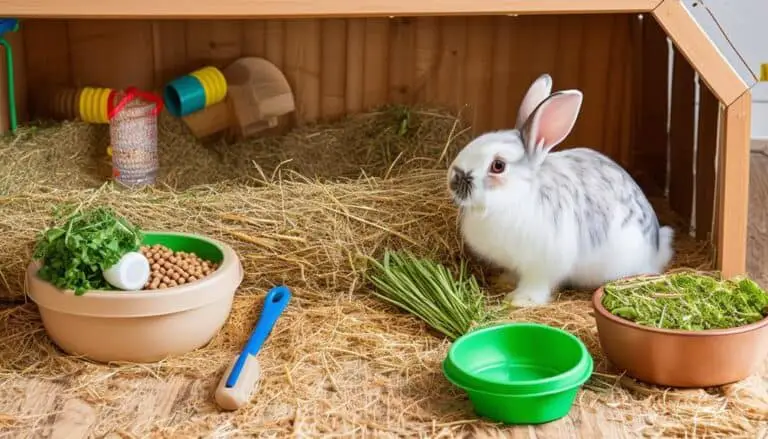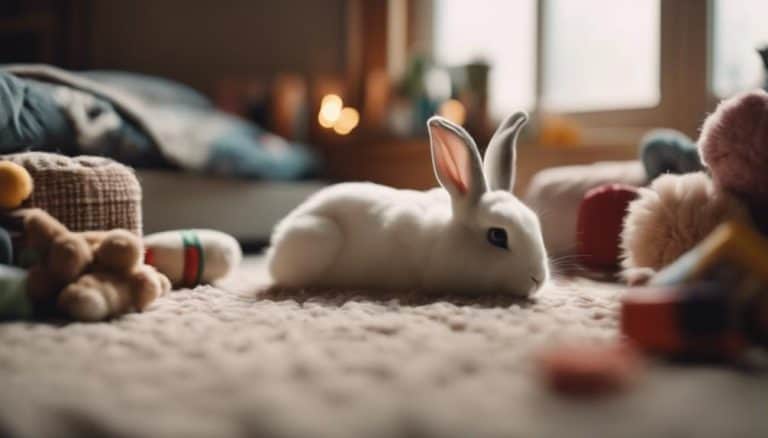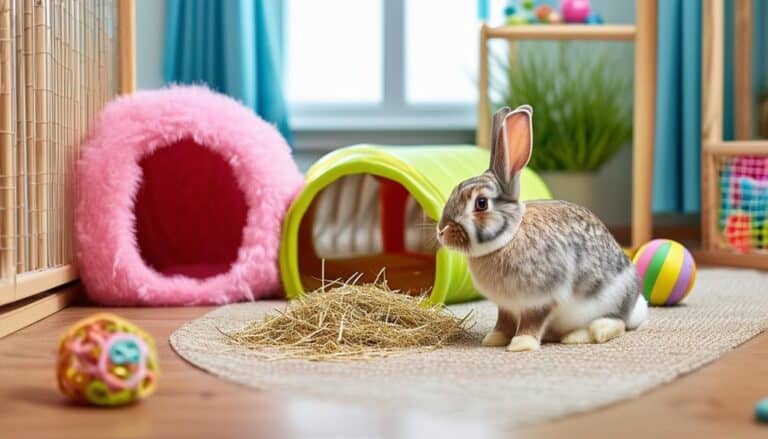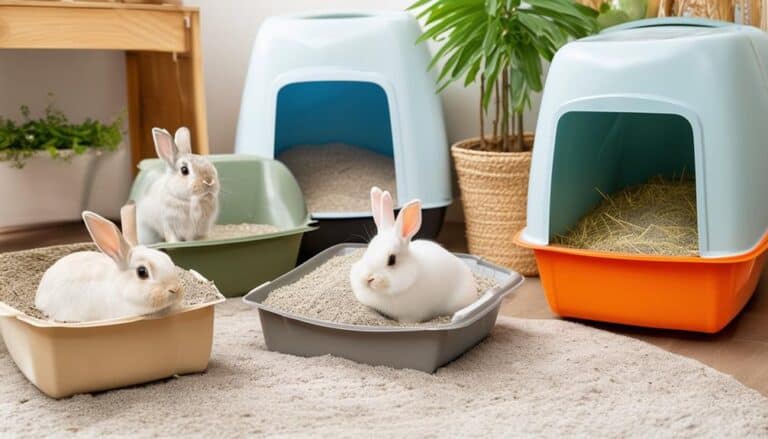Why Is My Pet Rabbit Lying on Its Side?
You’ve noticed your rabbit lying on its side and might wonder what it means. This behavior often indicates deep relaxation and trust, showing your pet feels safe and content in its environment.
However, it’s crucial to understand that not all reasons for this posture are positive. Sometimes, it could signal underlying health issues or stress that require immediate attention. To guarantee your rabbit’s well-being, you’ll need to look for specific signs and take appropriate action if necessary. So, what exactly should you watch for, and when should you be concerned?
Common Reasons for This Behavior
When you see your rabbit lying on its side, it often means they feel safe, relaxed, and comfortable in their environment. This behavior, known as a rabbit flop, is a strong indicator that your pet feels secure. The act of flopping isn’t just a random occurrence but a sign of deep trust and contentment.
As a pet owner, it’s important to understand that a rabbit lying on its side is displaying a natural behavior that reflects their well-being. This position often indicates that your rabbit feels safe enough to let its guard down. Despite their relaxed state, rabbits may sleep with their eyes open, which showcases their inherent vigilance.
Creating an environment where your rabbit feels safe is key to encouraging this behavior. Make sure they’ve a quiet, secure space away from potential stressors. By providing such an environment, you enable your rabbit to express its natural behaviors freely, leading to a happier and healthier pet.
Signs of Relaxation
You’ll notice your rabbit’s calm breathing patterns and flopped ears as key signs of relaxation. When a rabbit’s breathing slows and becomes steady, it indicates a relaxed state.
Flopped ears, laying loosely on their head, further signal that your rabbit feels secure and content.
Calm Breathing Patterns
A rabbit lying on its side with deep, rhythmic breathing is a clear indicator of relaxation and comfort. When your pet displays calm breathing patterns, it signifies that they feel secure and at ease in their environment. This behavior isn’t just a random occurrence but a natural and common sleeping position that reflects their peaceful state of mind.
Observing your rabbit lying on its side with these calm breathing patterns can be a heartwarming display of their well-being. It’s a strong sign that they trust their surroundings and feel content. Your rabbit’s deep, rhythmic breathing indicates that they’re experiencing a state of tranquility and are free from stress or fear.
Understanding these calm breathing patterns can help you better cater to your rabbit’s needs. By providing a safe and comfortable environment, you’re promoting this relaxed behavior and reinforcing their sense of security. This, in turn, fosters a trusting relationship between you and your pet.
Recognizing and appreciating these signs of relaxation ensures that your rabbit thrives in a peaceful, loving home.
Flopped Ears Behavior
Noticing your rabbit with flopped ears while lying on its side indicates a state of deep relaxation and a sense of security. This body language suggests that your rabbit feels safe and comfortable in its environment. When a rabbit lays on its side with its ears pointed downward, it’s a clear sign of contentment and trust.
Here are four visual cues to help you identify this relaxation behavior:
- Flopped Ears: When your rabbit’s ears aren’t upright but rather relaxed and flopped to the side, it’s a strong indicator of their comfort.
- Side-Lying Position: A rabbit laying on its side is often in a deep state of rest, showing its vulnerability and trust in its surroundings.
- Soft Breathing: Calm and rhythmic breathing usually accompanies this relaxed state, further signaling your rabbit’s comfort and tranquility.
- Loose Limbs: Limbs that aren’t tucked under the body but instead sprawled out casually reflect a rabbit’s peaceful state.
Understanding these signs can help you better appreciate your rabbit’s body language and overall well-being. Recognizing when your rabbit feels secure allows you to maintain an environment that fosters this sense of peace and relaxation.
Indicators of Illness
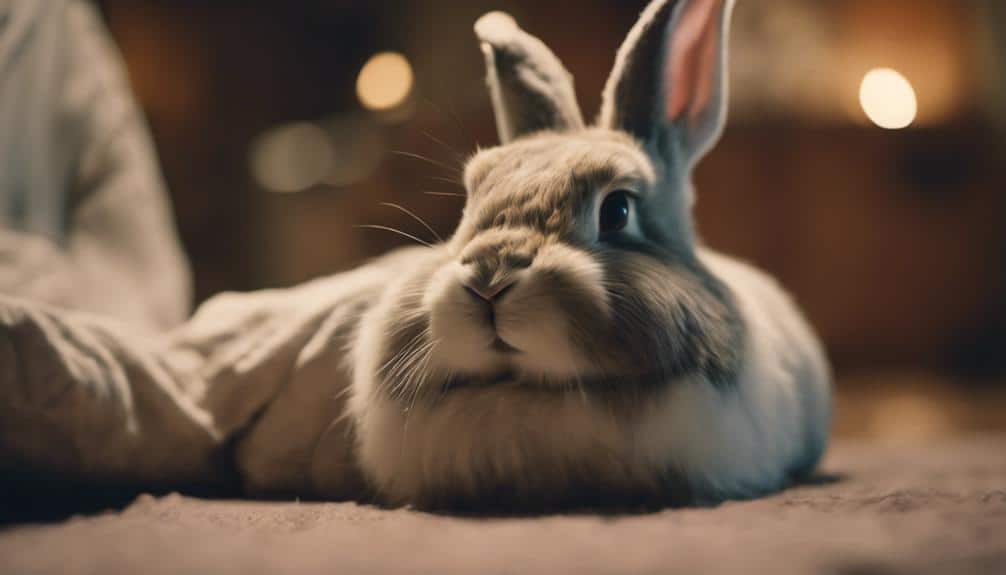
Identifying the early signs of illness in pet rabbits is crucial for ensuring their health and well-being. When a rabbit is sick, it might exhibit several symptoms that could indicate underlying health issues. One of the most noticeable signs is a head tilt. If you observe your pet bunny holding its head at an unusual angle, this could be a sign of an ear infection or a neurological condition.
A rabbit lying on its side in an uncharacteristic manner, especially if it’s accompanied by lethargy or lack of appetite, should raise concerns.
Other indicators of illness in rabbits include changes in eating habits, reduction in fecal output, or noticeable weight loss. If your rabbit is usually active and suddenly becomes more withdrawn or shows signs of discomfort, closely monitoring these behaviors is crucial.
Additionally, respiratory symptoms like sneezing, nasal discharge, or labored breathing can signal that your pet bunny needs immediate veterinary attention.
Stress and Anxiety
Stress and anxiety in pet rabbits can arise from environmental stressors. These stressors include loud noises, unfamiliar scents, or sudden movements. Social interaction issues, such as improper handling or isolation, can also contribute to their distress.
To manage these behaviors effectively, it is essential to observe your rabbit’s environment and interactions closely. Consulting a rabbit-savvy veterinarian for tailored advice can also be beneficial.
Environmental Stressors
Environmental stressors, such as loud noises and sudden movements, can greatly impact your rabbit’s mental well-being. When exposed to these stressors, rabbits may exhibit side lying behavior as a coping mechanism. It’s important to recognize the environmental stressors that could be affecting your pet rabbit and take steps to mitigate them.
Here are some common environmental stressors that might be causing your rabbit to lie on its side:
- Loud noises: These can include anything from household appliances to nearby traffic. Loud, sudden sounds can startle your rabbit, causing significant stress.
- Sudden movements: Quick, unexpected actions around your rabbit can trigger anxiety. Rabbits are naturally cautious animals, and abrupt movements can make them feel threatened.
- Changes in routine: Rabbits thrive on consistency. Any sudden changes in their daily schedule, such as feeding times or playtime, can cause unease.
- Feeling threatened: The presence of other animals or even unfamiliar humans can make your rabbit feel insecure.
Creating a calm and secure environment will help reduce these stressors, ultimately preventing side lying behavior. Identifying and addressing these factors is essential for maintaining your rabbit’s overall well-being and mental health.
Social Interaction Issues
Understanding environmental stressors is just one part of the equation; social interaction issues can also lead to stress and anxiety in pet rabbits. When your rabbit is lying on its side, it might be overwhelmed by social dynamics. Loud noises, sudden movements, or even the presence of other pets can trigger stress. It’s essential to identify these stressors to mitigate their impact.
Creating a safe, quiet, and comfortable environment is vital to reducing social interaction issues. Rabbits need a calm space where they feel secure. Consider rearranging their habitat to minimize exposure to stress-inducing elements.
Consulting a veterinarian or animal behaviorist can provide you with tailored advice on managing your rabbit’s stress and anxiety. They’ll help identify specific triggers and suggest effective interventions.
| Trigger | Impact on Rabbit |
|---|---|
| Loud Noises | Increased stress levels |
| Sudden Movements | Fear and Anxiety |
| Unfamiliar Environments | Feeling Threatened |
Being proactive about your rabbit’s social interactions can greatly improve their well-being. By understanding their stress triggers and adjusting their environment accordingly, you can help them feel more at ease, reducing instances of lying on their side due to stress.
Environmental Factors
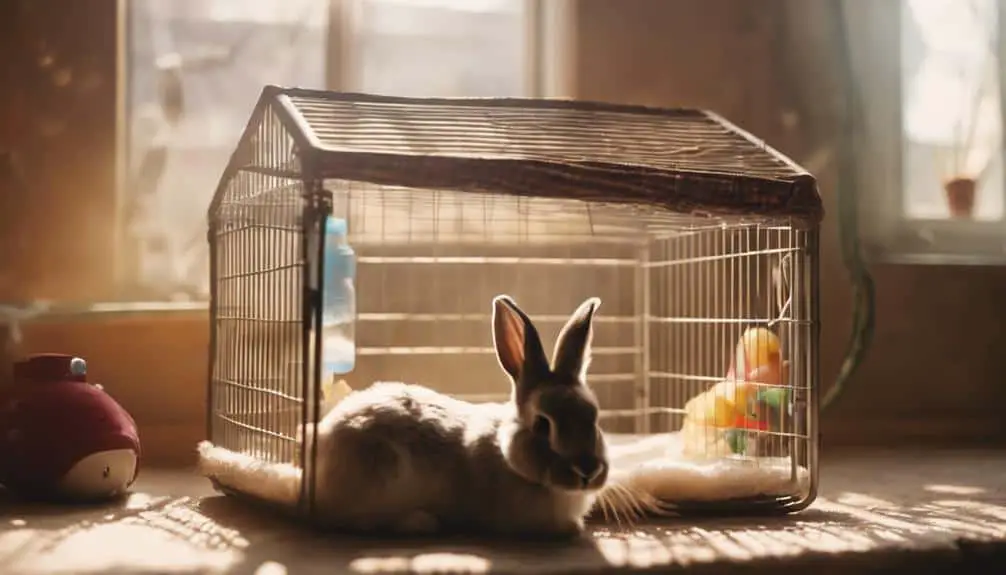
Establishing a cozy and safe environment is important for encouraging rabbits to relax and lie on their side. Environmental factors play a significant role in making your rabbit feel secure and comfortable enough to adopt this position. Since rabbits can’t sweat, lying on their side helps them regulate their body temperature.
Let’s look at some key environmental aspects that can make a difference:
- Temperature Control: Make sure your rabbit’s living space is neither too hot nor too cold. Ideal temperatures range between 60-70°F (15-21°C). Adequate ventilation and shade can help maintain a stable environment.
- Soft Bedding: Provide soft, absorbent bedding materials like hay or specialized rabbit bedding. This not only makes lying on its side more comfortable for your rabbit but also reduces stress on their joints.
- Lighting: Maintain a natural light cycle to mimic outdoor conditions. Avoid harsh artificial lights which can disturb their relaxation and sleep patterns.
- Noise Levels: Keep the living area free from loud noises and sudden sounds. Rabbits are sensitive to auditory stressors, and a quiet environment will help them feel secure enough to relax fully.
Monitoring Rabbit Health
Carefully monitoring your rabbit’s health is essential to guarantee their well-being and address any potential issues early.
Observing your rabbit lying on its side can be both a reassuring and informative sign. This specific sleeping position, often referred to as the ‘flop,’ typically indicates a deep state of relaxation and comfort. When a rabbit chooses to lie on its side, it reflects a high level of trust and security in its environment.
It’s important to recognize that a rabbit lying on its side can also occur with its eyes open. This might seem unusual, but it’s a natural behavior that demonstrates how safe and at ease your rabbit feels. However, while the flopped position is generally a sign of contentment and well-being, it’s crucial to stay vigilant for any changes in behavior.
If your rabbit is unresponsive, shows signs of distress, or refuses to eat while in this sleeping position, it could indicate a serious health issue. Monitoring these subtle cues can help you distinguish between normal, relaxed behavior and potential health concerns.
When to See a Vet
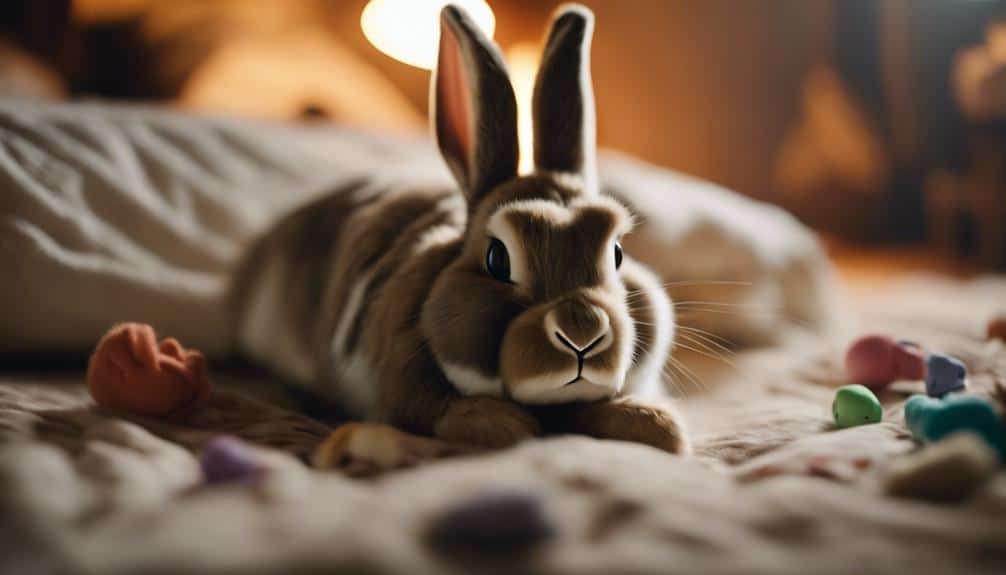
If your rabbit shows any signs of distress or unusual behavior, it’s vital to contact a rabbit-savvy vet immediately. Rabbits are prey animals and often hide symptoms of illness until they become severe. If your rabbit is lying on its side, especially if it’s unresponsive or showing other concerning signs, prompt veterinary attention is paramount.
Consider seeking veterinary attention if you observe the following:
- Lethargy: Your rabbit lacks energy and spends more time lying down than usual.
- Refusal to Eat: A sudden loss of appetite can indicate gastrointestinal issues or other health problems.
- Signs of Distress: Rapid breathing, vocalizations, or unusual movements suggest your rabbit is in pain or discomfort.
- Behavioral Changes: Any sudden changes in behavior, such as lying on its side without moving, can be a red flag.
Never ignore these signs, as they might indicate serious health issues requiring immediate intervention. A rabbit-savvy vet can diagnose and treat underlying conditions, ensuring your pet’s well-being.
Tips for a Happy Rabbit
Ensuring your rabbit’s happiness involves creating an environment that meets their physical and emotional needs. Start by providing a spacious, clean habitat where your rabbit can move freely and explore. This helps them feel secure and reduces stress, encouraging positive behaviors such as lying on its side in a relaxed sleeping position.
Nutrition is critical. Offer a balanced diet consisting of hay, fresh vegetables, and a limited number of pellets. Fresh water should always be accessible. A well-fed rabbit is more likely to exhibit signs of comfort and trust, such as the rabbit flop.
Social interaction is also key. Rabbits are social creatures. Spend time bonding with your rabbit to reinforce their sense of security. Regular, gentle handling and playtime can make your rabbit feel more at ease, promoting behaviors like lying on its side.
Lastly, maintain a consistent routine. Rabbits thrive on predictability. Regular feeding times and scheduled playtime can help them feel safe and content.
Monitor their overall behavior and body language. If your rabbit is frequently lying on its side with a relaxed demeanor, it’s a good indication they feel happy and secure in their environment.
Conclusion
To conclude, your rabbit’s behavior of lying on its side is often a sign of relaxation and contentment, indicating they feel safe and comfortable. However, it’s important to monitor for any signs of lethargy, unusual behavior, or other symptoms that might indicate illness. Make sure their environment is stress-free and enriching.
If you notice anything concerning, don’t hesitate to seek veterinary care. Prioritizing your rabbit’s well-being will help keep them happy and healthy.

